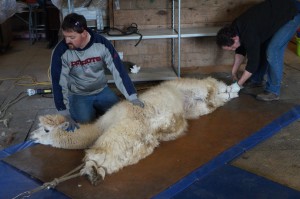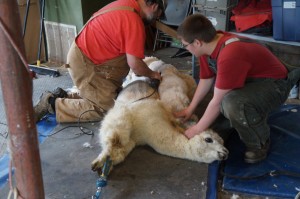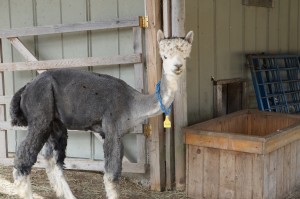It’s hard to find the words to describe an alpaca shearing. “Organized chaos” comes to mind. “Not easy” also works, as Mike Rowe of Dirty Jobs learned.
The process itself is pretty simple. An alpaca is lead to the shearing area and is then lowered to the ground to be stretched as long as it comfortably can be. The legs are tethered for stability, like this:
Don’t worry! The alpacas are not in pain while tied up.
Before our shearing begins, each animal is weighed. They get their toenails clipped and their teeth checked over. We administer vaccinations to keep the herd healthy for another year. A few alpacas will have their teeth filed down a bit. It’s like a doctor’s visit, a trip to the dentist, a manicure, and a hair cut – all in one easy location!
Alpacas are sheared once a year, in late spring before the summer heat sets in. The fiber is sorted by grades, determined by the thickness of the fiber. Grade 1 fiber is ultra fine, for example, and grade 6 is a “robust” fiber.
The best fiber comes from the alpaca’s back and sides. This fleece is known as “the blanket“.
We try to keep the blanket in one piece. To do this, the alpaca must be turned over as it is being sheared. Like this:
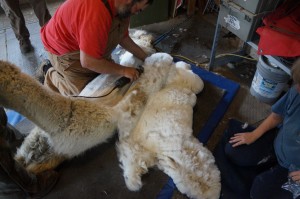
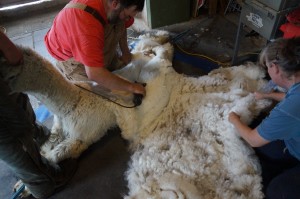 Ooooh! Look how soft the blanket looks. Don’t you just want to curl up with it?
Ooooh! Look how soft the blanket looks. Don’t you just want to curl up with it?
The blanket is bagged and labeled, so that we know which animal the fiber came from. Some blankets will be entered for judging at The Maine Fiber Frolic; most of it will be sent to the mill to be spun into yarn.
After the fiber from the belly is “snip-snipped”, the neck and legs get their turn. We call this fiber the “second and third cuts”. This fleece is used for felting, stuffing, and rug yarns.
 A few of the alpacas get a preview of what’s to come when their buddy comes through the waiting area.
A few of the alpacas get a preview of what’s to come when their buddy comes through the waiting area.
The shearing process takes several hours and a few volunteers. Someone ushers in an alpaca while another is sheared. Fiber is being bagged and binned. The ground is being swept. Fiber samples are going in one direction, vaccines in the other. Notes are written to record which animal received what treatment.
If you’re interested in learning more about shearing, you can get in touch with us! Click on the “Contact” page and send us your questions. For now, we leave you with these images of sheared alpacas rocking some goofy hair.

